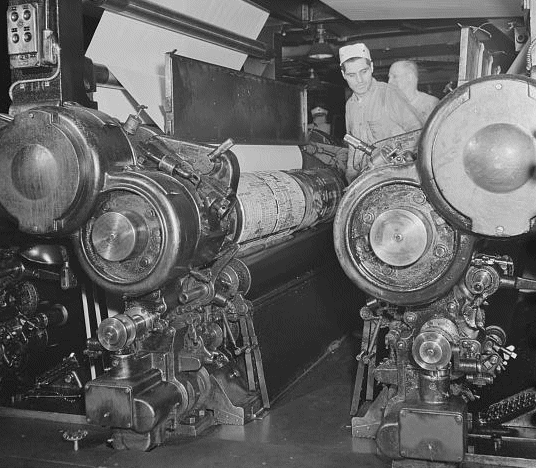| A B C D E F G H I J K L M N O P Q R S T U V W X Y Z |
Cachet
Found on many First Day Covers, a cachet is text or drawings privately applied to an envelope for a commemorative purpose. Most First Day Covers use only one stamp if the stamp meets the minimum postage requirements, but often blocks of four were used. The example at right may seem a bit excessive since the going rate for mailing a letter was then three cents!
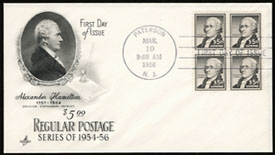
CAM
An acronym for "Contract Air Mail", CAM is US mail carried by private contractor that was charged a fee based on the number of zones the mail had to cross.

Cancellation
Any postal marking applied to a postage stamp to prevent its reuse. This includes methods such as punching a hole in the stamp, scraping the surface of the stamp, and slicing the stamp. The term "cancellation" is not synonymous with "postmark", although they are often used interchangeably.

Canceling Machines
Machines that cancel stamps and postmark envelopes in a single operation. Many different makes and models of canceling machines have been used by the various Post Offices.
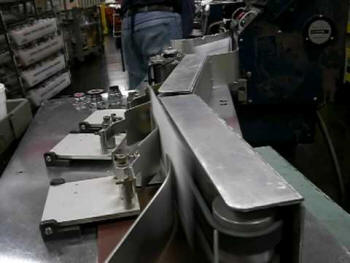
Canceled-to-order
(CTO) stamps cancelled with intention of being used for postage. Often countries will cancel their stamps before selling to discount brokers to insure that the stamps will not be ultimately used for postage. CTO stamps are less desirable than mint stamps or stamps that have been cancelled in the order use for postage.
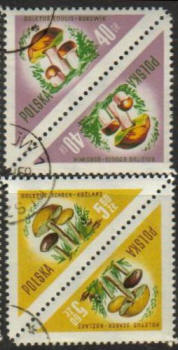
Cantonal stamps
Issues of Switzerland's cantons (states) used before the release of national stamps. The cantonal issues of Basel (1845), Geneva (1843-50) and Zurich (1843-50) are among the classics of philately.
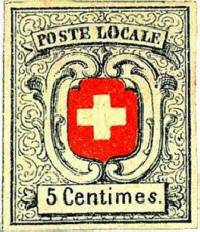
Cape Triangles
Commonly used name for the triangular Cape of Good Hope stamps of 1853-64, the first stamps printed in triangular format.
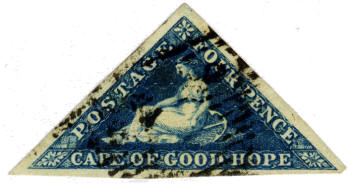
Carrier Stamps
Prior to July l, 1863, US postage only paid for transportation of mail between post offices. Patrons would have to visit the Post Office to drop off and pick up their mail. In about 50 of the larger U.S. cities, primarily in the New England states, independent carrier services arose, sometimes among fierce competition, providing for a fee of usually one or two cents, drop off or delivery of letters and packages to the nearest Post Office. Stamps that paid for this carrier service are known as "Carrier Stamps".

Catalog value
The value of a stamp as listed in a given catalog for the most common condition in which the stamp is collected. Some catalogs list stamps at a retail value, though actual dealer prices may vary substantially for reasons of condition, demand or other market factors. Most catalogs have a set minimum value for the most common stamps.
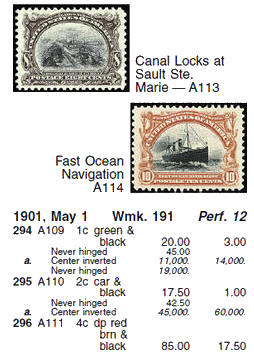
CDS
An acronym for "Circular Date Stamp" used by many coutnries over the decades.

Centenary International Philatelic Exhibition
About once per decade, international stamp shows were held in New York City. Since 1947 was the centenary year for U.S. postage stamps, a stamp, and the souvenir sheet at right were issued in conjunction with the exhibition.
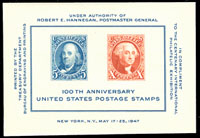
Center Line Block
Many of the sheets printed for U.S. postage were separated into smaller panes before being sent to post offices. As a guide in cutting the sheets, two perpendicular guide lines were added through the center of the sheet dividing it into four equal pieces. A block of four stamps from the very center of the sheet contains the two intersecting guidelines.
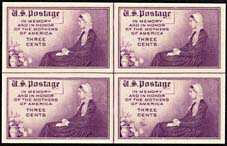
Centering
The relative position of the design of a stamp in relation to its margins. For collectors of U.S. stamps with no faults, centering is of prime importance in determining value.

Censored mail
A cover bearing a handstamp or label indicating that the envelope has been opened and the contents inspected by a censor.

Certificate of Authenticity
A certificate from a recognized authority attesting to the genuineness of a philatelic item.

Certificate of Mailing
A US service that provides evidence of mailing, first made available in 1915. A certificate of mailing cost one cent per item from July 1, 1929 until February 1, 1954. Mailing books, as shown at right, could serve as certificates for multiple mailings.
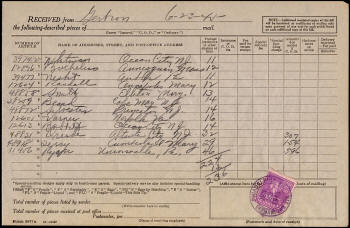
Certified Mail
In 1955, the US post office began a service that provided a mailing receipt, a delivery record, and requiring the signature of the recipient.

Chads
The bits of paper removed in the perforating process. If a chad is not removed properly it results in what is known as a "blind perf". It is considered unethical and will lower the value of a stamp if the chads are removed by the collector in a discernible way such as punching them out with a perforating tool, since in a way it is destroying a bit of philatelic history.

Chalky paper
A chalk-surfaced paper for printing stamps. Any attempt to remove the cancel on a used chalky-paper stamp will also remove the design. Immersion of such stamps in water will cause the design to lift off. Touching chalky paper with silver will leave a discernible, pencil-like mark and is a means of distinguishing chalky paper.

Changeling/Color Changeling
A stamp whose color has been changed through a chemical reaction, either natural or artificial. The stamps show just how drastic the color change can be; often fooling inexperinced collectors into thjinking they have something rare.

Charity seals
Adhesive labels that are distributed by a charity such as Christmas Seals. They have no postal validity, although they are often affixed to envelopes.
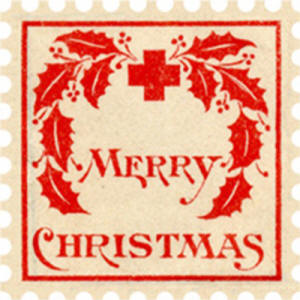
Chase, Carroll
A great American philatelist renowned for his work on the US three cent stamp of the 1851 issue.
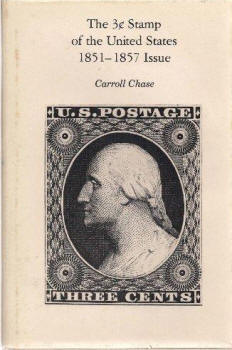
China Clipper
The nickname of the Martin M-130 seaplane, depicted on the three US "China-Clipper" Air Mail stamps of 1935 and 1937. The China Clipper carried mail across the Pacific to and from San Francisco, with inaugural service to Manila via Honolulu and Guam on November 22, 1935. By 1937 this route had been expanded to include Hong Kong.

Cinderella
An adhesive label that is not a postage stamp. Cinderellas include seals and bogus issues, as well as revenue stamps, local post issues and other similar items. They often do not have a denomination.

Classic
An early stamp issue. "Classic" often has a connotation of rarity, but many classic stamps are decidedly common, for example the US three cent stamp of the 1861 issue, US 65, and in fact, a scarce recent item may be properly referred to as a "modern classic".

Cleaned
Soiled or stained stamps are sometimes cleaned with chemicals to improve the appearance of the stamp. Sometimes a cancellation is removed by cleaning, making a used stamp appear unused. Unless it is done to preserve the stamp, both practices are unethical, and are easily detected by experienced collectors. Cleaning usually lowers the value of the stamp.
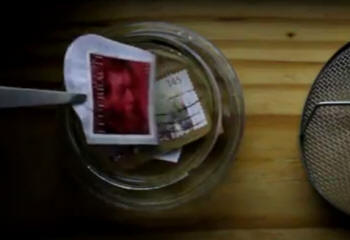
Clipper
A generic name for the US planes flown by Pan American on its trans-Atlantic and trans-Pacific routes.

Closing of the Mail
The time of day after which mail will no longer be accepted by a local post office, without a late fee, for dispatch to a train or ship.
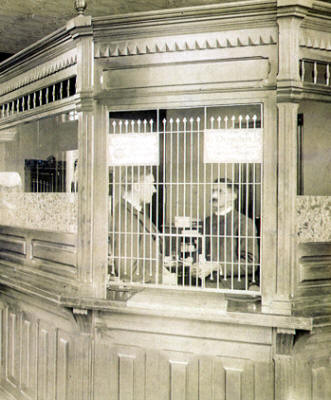
Coil Leader
A strip of paper attached to the first stamp in a coil stamp roll (the leader).

Coil Stamps
Coil stamps are long rows of stamps, a single stamp wide, placed either end-to-end or side-by-side. Most U.S. coils have a straight edge on the two parallel sides not attached to other stamps and perforations on the two parallel sides attached to other stamps.

"COIL STAMPS"
Marginal markings on some of the US one and two cent stamps of 1914, US 424 and 425. When the production of rotary press coil stamps proved satisfactory in 1914, the remainder of the flat plate sheets destined to become coil stamps were set aside as waste. The "COIL STAMPS" inscription was normally trimmed off the sheet during coil production, but it remained on the sheets that were set aside and later used for the regular issue. These were the first of the "coil waste" stamps, but can only be distinguished from the normal stamps, those printed on normal "non-COIL" plates, if they have part of the "COIL STAMPS" inscription or one of the 8 plate numbers in the selvage. The eight plate numbers are - on the one cent: 6581, 6582, 6585, and 6589 and on the two cent: 6568, 6570, 6571, and 6572.
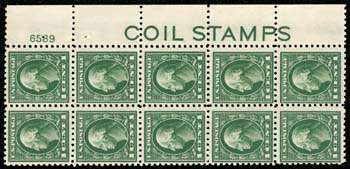
"COIL STAMPS"
Marginal markings on some of the US one and two cent stamps of 1914, US 424 and 425. When the production of rotary press coil stamps proved satisfactory in 1914, the remainder of the flat plate sheets destined to become coil stamps were set aside as waste. The "COIL STAMPS" inscription was normally trimmed off the sheet during coil production, but it remained on the sheets that were set aside and later used for the regular issue. These were the first of the "coil waste" stamps, but can only be distinguished from the normal stamps, those printed on normal "non-COIL" plates, if they have part of the "COIL STAMPS" inscription or one of the 8 plate numbers in the selvage. The eight plate numbers are - on the one cent: 6581, 6582, 6585, and 6589 and on the two cent: 6568, 6570, 6571, and 6572.

Columbia Postal Supply Co.
The Columbia Postal Supply Company of Silver Creek, New York produced a variety of US cancellation machines from around 1900 until the 1950s.

Columbian Exposition
The nickname for the first US commemorative series of postage stamps, issued in 1893 to commemorate the 400th anniversary of the landing of Columbus in the New World, but also to promote the World's Columbian Exposition held in Chicago in 1893. Although the Exposition lasted from May 1 to October 30, 1893, the ticket at right was issued for admission for just a single day, Chicago Day, October 9.
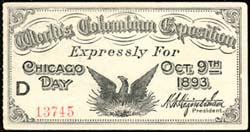
Combination cover
A cover bearing the stamps of more than one country when separate postal charges are paid for the transport of a cover by each country. Also stamps of the same country canceled at two different times on the same cover as a souvenir.
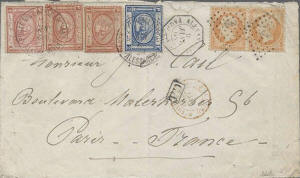
Comb Perforation
A method of perforation that perforates three sides of a stamp at once. A comb perforator has a long row of pins with short rows of pins equal to the size of the stamp running at right angles to it. Each stroke of a comb perforator makes perforations in the pattern of a comb. The comb perforator need only be run in one direction, since the vertical columns of perforations, the teeth of the comb, are cut into the sheet as each horizontal row is added. Understanding the distinction between a comb perforator in which the perforations line up correctly both horizontally and vertically, and the line perforator, which almost always has overlapping horizontal and vertical perforations, may provide clues as to the authenticity of a stamp, since many early stamp were perforated using line perforators, and the perfs should not line up exactly.
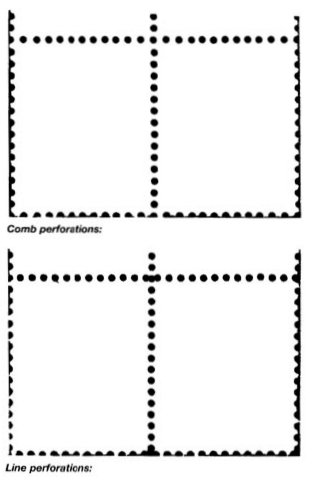
Commemorative
A stamp placed on sale in limited quantities and for a limited period of time, often honoring a person, place, or event, but also used to promote certain, then current, events.
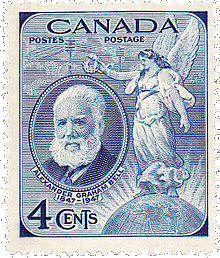
Commercial Cover
A cover of apparent commercial origin, as opposed to philatelic origin, presumably the only way to be certain a stamp was used for the purpose for which it was intended and not for philatelic reasons.

Compound Perforation
Two different gauges of perforations used on the same stamp.
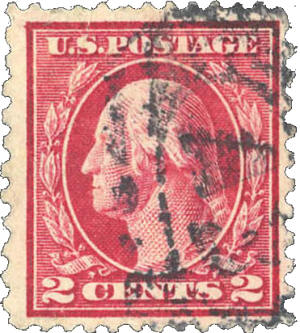
Condition
The overall appearance and soundness of a stamp or cover, often the over-riding factor in the determination of the value of a stamp. Desirable "conditions" include fresh full color, a light, legible and well centered cancellation on the used stamp, full original never hinged gum on the unused stamp, sound perforations, etc. Undesirable features include creases, tears, thinned paper, short perforation teeth, and toning, among others.
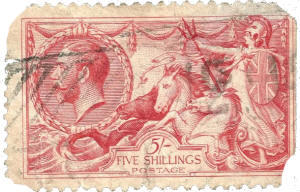
Continental Bank Note Co.
The Continental Bank Note Company held the contract to print U.S. postage stamps from 1873 to 1879. The stamps were printed on a hard white paper, helping to distinguish them from the American Bank Notes that followed. Continental added a secret mark to many of the Bank Note denominations, but not all, in order to distinguish their stamps from the National Bank Note Printings.

Contract Air Mail (CAM)
The transport of airmail by private contractors over established routes.

Control Perfin
Perforations through the face of a Schermack or Mailometer privately produced US coil stamp. The perforations were in the design of the initials or insignia of the company that used the stamps for mass mailing. This was done in an attempt to thwart theft of the companies stamps, since the control perfin should not be found on any other correspondence than that of the company itself.
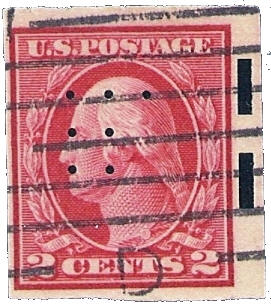
Convention Rate
(Treaty Rate) - a special postal rate negotiated between the US and a foreign country.
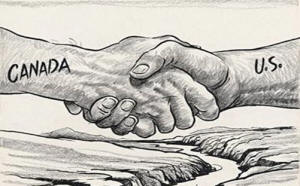
Cork Cancel
A canceling device made by cutting a design out of cork by or at the direction of a local postmaster. Most of these "cork cancels" are very collectible, in particular the US Waterbury cancels.

Counterfeit
Although the terms are often used interchangeably, counterfeit and fake have slightly different meanings. A counterfeit stamp is designed to deceive postal authorities, i.e. a two cent stamp is counterfeited in the hope of gaining two cents worth of postage, while a two cent fake is produced in the hopes of gaining philatelic value from a collecting standpoint. The stamp shown is an "offset" counterfeit of the US 2¢ rotary stamp. The perforations are a dead giveaway to most collectors, the color is a little off, and the stamp is offset and not engraved. Yet these counterfeits fooled postal authorities for some time. The perpetrators were eventually nabbed and served jail time. The term counterfeit also covers altered cancellations or covers intended to be accepted by others as genuine.
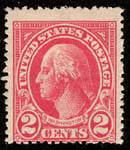
Covel Coils
From about 1914-1916, the US Covel Manufacturing Company of Benton Harbor, Michigan privately perforated imperforate stamps, US 314 and 408 for use on their advertising mailers.

Cover
Usually refers to any intact envelope, folded letter, postal card, or wrapper. The "cover" may have a stamp on it or may be "stampless" if mailed in the "stampless era". The term "cover" also applies to the front and back cardboards protecting booklet stamps, known as booklet covers.

Cracked Plate
Collectors consider a printing plate to have a "crack" if the crack shows up on the stamps printed from that plate. Cracks that get worse with progressive prints are termed "progressive" cracks and are collectible as such.
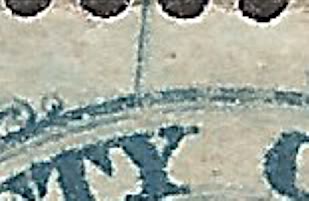
Crash cover
A cover that has been salvaged from the crash of an airplane, train, ship or other vehicle. Such covers often carry a postal marking explaining damage or delay in delivery.

Crease
A noticeable weakening of the paper of a stamp or cover, caused by its being folded or bent at some point. Creases substantially lower a stamp's value. Creases particularly affect cover values when they extend through the attached stamp or a postal marking. Stamp creases are visible in watermark fluid.

Cross Gutter Block
A block of stamps from the center of the printed sheet containing the intersection of the vertical and horizontal gutters. Very few issues were printed with the internal "gutters" wide enough to create a "cross gutter" block. They are, however, found on many of the Farley issues.
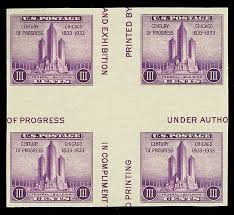
"CS"
A US marking found in the top margin of the Georgia Bicentennial stamp (Oglethorpe). The letters "CS" indicate that the plate had been chromium plated.

CTO
(Cancelled to order) stamps cancelled with on intention of being used for postage. Often countries will "cancel" their stamps before selling to discount brokers to insure that the stamps will not be ultimately used for postage. CTO stamps are less desirable than mint stamps or stamps that have been cancelled in the order use for postage.

Cut cancellation
A cancellation that intentionally slices into the stamp paper. Often a wedge-shaped section is cut away. On many issues, such cancellations indicate use of postage stamps as fiscals (revenues) or telegraph stamps rather than as postage. Cut cancellations were used experimentally on early United States postage stamps to prevent reuse.

Cut square
A neatly trimmed rectangular or square section from a stamped envelope that includes the imprinted postage stamp with ample margin. Collectors generally prefer to collect stationery as entire pieces rather than as cut squares. Some older stationery is available only in cut squares.
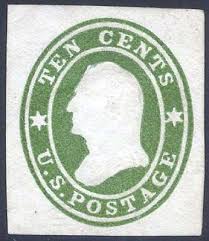
Cut-to-shape
A nonrectangular stamp or postal stationery imprint cut to the shape of the design, rather than cut square. Cut-to-shape stamps and stationery generally have lower value than those cut square. One of the world's most valuable stamps, the unique 1856 British Guiana ""Penny Magenta"" (Scott 13), is a cut-to-shape stamp.

Cylinder
A curved printing plate used on a modern rotary press. The plate has no seams. For United States stamps, cylinders are used to print gravure stamps.
